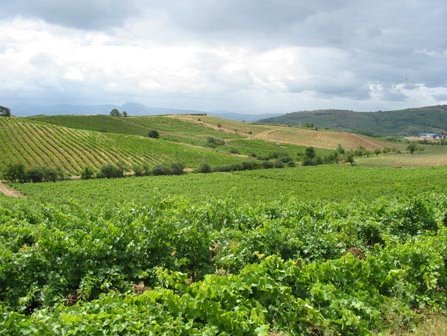This week begins the first of many future "Where in the world is...?" forays into fantastic unknown wine regions around the world. With so many different grape growing areas, I wanted to start showcasing those that produce amazing, quality wines that are truly unique. The best part is that the wines from most of these offbeat appellations are exceptional values.
The reasons that I wanted to cover this 4,200-hectare region comes from the fact that my friend, Dennis, and his wife, Bethany, are in Spain for the next two weeks and I am supremely jealous.
The other impetus was a fantastic bottle of 2007 Bierzo from Descendientes de J. Palacios Pétalos that Phil Bilodeau, owner of Thief Wine, brought as a special treat to the Park Lafayette tasting event this past Wednesday.
Bierzo Background Bierzo (Bee ērht so) is located in northwestern Spain just north and east of Valdeorras in the Castilla y leon. This DO (Denominación de Origen) is a little gem that has recently begun cranking out some amazing wines. The primary red grape varietal, and shining star of the region, is Mencía, which until recent DNA proof to the contrary, was thought to be related to Cabernet Franc. Mencía is known for its delicate but forward fruit flavors, silky tannins, and its innate ability to thoroughly express the terroir of the region. Many of the Mencía vines in Bierzo are 60 to 100 years old. Other varietals include: Red-Negra, Garnacha Tintorera, Merlot, Cabernet Sauvignon and Tempranillo, and for white - Doña Blanca, Palomino, Malvasia and Godello.
Historically, the Bodegas (wineries) in Bierzo produced largely weak and unmemorable wines. But the last two decades have seen superstar winemakers focus on hillside plantings for better exposure and drainage. Some have said that the vineyards are some of the most beautiful in all of Spain with plantings arranged on steep slopes and terraces. Modernized winemaking techniques such as state-of-the-art equipment, the use of American Oak and the incorporation of organic and biodynamic practices have vastly improved the quality and ageability of the Mencía grape in particular over the last 10 years
The physical qualities that make Bierzo special revolve around its unique geographic location and the soil structure. Bierzo is surrounded by mountains which protect it from the harsh temperatures that are prevalent in much of the rest of Spain. Instead of scorching hot sunny days and cold ocean breezes at night, the mountains help to create a more temperate climate. The soil ranges from alluvial iron clay near the rivers to high mineral content in the schist, slate and quartzite higher up the slopes. This further protects against inclement weather, promotes ideal water drainage and at the same time requires the vines roots to dig deep for nutrients resulting in higher quality fruit.
The Big Boy(s) of Bierzo
It's hard to mention quality Mencía in Bierzo and not hear Alvaro Palacios in the very same sentence. Alvaro Palacios and his nephew Ricardo Pérez Palacios operate the Descendientes de J. Palacios and are responsible for outstanding wines from several regions in Spain, including Valdeorras and Priorat. Dubbed the "King of Priorat", Alvaro Palacios was named one of 50 "Most Influential Winemakers" by Wine & Spirits Magazine in 2004. He has attained such acumen in Bierzo that it has been said that "Palacios is Bierzo".
The two wines from the Descendientes de J. Palacios label that he is most know for in Bierzo are the Petalos, and the Villa de Corullón. As is typical of most Mencía from Bierzo, the Petalos is 100% Mencía. The 2007 Petalos is the lighter of the two, with warm red and black raspberry, slightly gamey fruit, licorice, anise and wonderful baking spices. Even young, the tannins are approachable due to a mere four months oak aging. Wonderful minerality through the midpalate gives way to a rich and lengthy finish.
The Villa de Corullón, also 100% Mencía, is the bigger brother all from hillside vineyards. Darker and more intense in all categories, but with underlying delicacy and beautiful representation of the soil and climate, this is a magnificent wine capable of some decent aging. Aged in all French Barrique, only 2,000 cases are produced.
Another hot new bodega is Dominio de Tares. Even though the vineyards are old, everything else about this winery is brand new and modern. All new state-of-the-art equipment, hot young winemakers and cutting edge techniques all come together to make Mencía shine. Most notable is the Exaltos Cepas Viejas which sees 9 months in American oak. Only 15,000 bottles were produced from the 60 year old vines. The 2006 is full bodied and elegant with a little chocolate and caramel following a dark cherry and raspberry beginning.
Make sure to check out the Albares and Bembibre from Dominio de Tares as well if you can find them. Very hard to get, but very worth it.
Other producers of note: Bodega del Abad, Paixar (run by the son of Mariano Garcia-former winemaker for Vega Sicilia), Pittacum, and Bodegas Estafania.
Food Pairings
Although the styles differ from producer to producer, Mencía, as mentioned before, has the wonderful ability to express its locale. As such, some generalizations can be made as to ideal food pairings.
The obvious choices are roasted meats and game. Venison, bison, elk, lamb all would be perfect platform proteins with which to start. Game bird such as pheasant, quail and duck would also work nicely. When adding in starch and vegetable and accoutrement, be careful not to rely on too many fruit bases compotes or sauces, especially red fruit. For example, pheasant with a bitter green (Lacinato Kale or Swiss Chard) and roasted chestnuts or Marcona almonds would normally be great with a cherry compote or reduction, but that red fruit will kill the subtle fruit in the Mencía. Focus instead on ginger, savory sauces and if you really want fruit use black fruits (plums, blackberries) and make sure the fruit is minimal.
Also, getting into the classic Spanish vibe of olives and cured meats with hard cheeses such as raw mile aged Manchego from Calstile-La Rioja-Leon, Grazalema from Andelucia or Montsec from Catalonia
Last note is to stay away from high acids and vinegars. Mencía has good acidity naturally, but the warm fruit flavors and subtle tannins won't play nice with balsamics, tomatoes or other high acids.
Bierzo wines are made in super small quantities and can be very hard to find. But when you do, they are so worth the experience of tasting something wonderfully unique and very well made -- usually for less than $30 a bottle.
Contact your local wine guy to see if they have any, if not, they will be happy to order some for you.
Anyone have any personal experience with wines from Bierzo?



